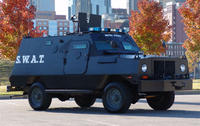-
Minneapolis man single-handedly battles Islamic extremism

Individuals like Abdirizak Bihi, who single handedly tries to keep young Somali-American teenagers from becoming radicalized, are part of a growing trend that officials in Washington call “CVE,” combatting violent extremism; since the 9/11 attacks, there have been fifty-one domestically produced jihadist plots or attacks in the United States and that number is steadily growing
-
-
BVS combats jail cell phone smuggling

Prisons across the United States are struggling to prevent cell phones from falling into inmates’ hands; in 2010 more than 10,000 contraband cell phones were confiscated from inmates in California prisons; to help officials crack down on these contraband items, Berkeley Varitronics Systems has developed a suite of sophisticated cell phone detectors that can “sniff” out phones even when they are hidden in the most obscure places
-
-
The art of signature replication
A Rockville, Maryland company’s signature replication technology is so advanced, DHS sends its agents there to learn; using sophisticated computer software and its Autopen signing machines, Damilic is capable of replicating signatures that so closely resemble the original hand written version, forensic scientists are needed to be able to tell the difference
-
-
Deterring cyberwar, police gear and the law, guarding the guardians
Gen. James Cartwright, vice chairman of the Joint Chiefs of Staff, described the current U.S. cyberdefense policy as “too predictable”; he added that “[the current policy is] purely defensive. There is no penalty for attacking us now. We have to figure out a way to change that”; he said the new U.S. cyberdefense policy is the first step toward correcting current deficiencies; a Massachusetts company is selling local police forces a new iPhone app that scans a suspect’s iris and matches it to a national database of felons; there are questions about whether or not this app — which costs $3,000 — violates the Constitutional prohibition of unreasonable searches; the former mayor, the police chief, and member of the city council of a New Mexico border town have been charged with smuggling guns to the Mexican cartels; some of these guns have been linked to at least eight murders in Mexico
-
-
Senator Schumer demands release of northern counternarcotics strategy
Senator Charles Schumer (D-New York) is demanding that the Office of National Drug Control Policy (ONDCP) release its Northern Border Counternarcotics strategy immediately; the strategy was due on 5 July as stipulated by a law passed in January; the law came in response to a to a Government Accountability Office (GAO) report which found that only thirty-two miles along the nearly 4,000 mile U.S.-Canada border had “an acceptable level of security”
-
-
AntiSec hacks IRC Federal, posts passwords online
Last Friday, AntiSec, a prominent hacking group, announced that it had successfully infiltrated the servers of IRC Federal; the company has contracts with several major government agencies including the Department of Justice, the Army, Navy, and NASA; in an announcement on their website, AntiSec wrote, “We laid nuclear waste to their systems, owning their pathetic Windows box, dropping their databases and private emails, and defaced their professional looking website”
-
-
Divorce leads to approval of GPS tracking in New Jersey
A divorce case in New Jersey has resulted in the first time a state court has approved the use of GPS devices to track individuals; last week a New Jersey appellate court ruled against a man who sued his ex-wife for placing a GPS device in the car she and her husband shared
-
-
Pilot programs reduce texting while driving by at least one third
Two pilot programs launched by the National Highway Traffic Safety Administration (NHTSA) aimed at minimizing texting while driving have reduced the practice by at least one third; the programs ran for one year starting in April 2010 and used a combination of stepped up law enforcement and public information campaigns in Syracuse, New York and Hartford, Connecticut
-
-
Peachtree City police win technology award for traffic enforcement
The Peachtree City police department in Georgia recently won the annual National Law Enforcement Challenge’s Technology award for its innovative approach to traffic safety; with the use of a “data driven” approach to traffic safety, the Peachtree City excelled in occupant protection, deterring driving under the influence, and enforcing speed limits
-
-
Also Noted
GPS tracking rules * License plate readers are “hot” * NC police get help online * 25 years for LoJack * PA police get patrol car web access
-
-
North Carolina jail investigated for immigration violations
A jail in North Carolina is currently under federal investigation on charges that local law officers mistreated detainees held as part of an immigration enforcement program; the investigation comes at the request of the state’s American Civil Liberties Union (ACLU) which requested that DHS officials investigate the Wake County jail based on fifty-seven complaints made by individuals detained there in 2009 and 2010; the complaints stem from the 287(g) program which allows local police officers to enforce federal immigration laws
-
-
Clip-on camera helps Mississippi police
The small police force at Walls, Mississippi, has technology on its side: a $60 clip-on camera, the size of a pack of gum, which the officer attaches to the front pocket of his or her uniform; the cameras hold a small memory card, capable of recording hours of evidence; the cameras have never been challenged in court
-
-
Butte County police lobbies for armored vehicle

For the second year in a row local law enforcement officials in Butte County, California are rallying to obtain grant money to help purchase an armored vehicle; if money from 2011 DHS grants is allocated to Butte County by the state, officials say it would be used to purchase an armored vehicle for the Butte County Sherriff’s Office and Chico
-
-
New Haven, Connecticut police begin installing security cameras
New Haven police plan to install twenty-one surveillance cameras in the city’s hot spots for crime. The cameras will give officers a 360 degree view of an area’s streets and sidewalks; police hope that the cameras will help reduce New Haven’s rising violent crime rate; in the first half of 2011, more than eighteen people have been killed
-
-
Austin fights to keep federal money to battle cartels
With federal lawmakers struggling to reduce spending and cut the deficit, Austin, Texas, could lose as much as $2 million in federal grant money that it uses to combat Mexican drug cartels; on Tuesday, Austin police chief Art Acevedo and Representative Michael McCaul (R-Texas) urged lawmakers not to cut their funding citing the fact that the city is a dangerous hub for drug cartels
-
More headlines
The long view
How Male Grievance Fuels Radicalization and Extremist Violence
Social extremism is evolving in reach and form. While traditional racial supremacy ideologies remain, contemporary movements are now often fueled by something more personal and emotionally resonant: male grievance.
